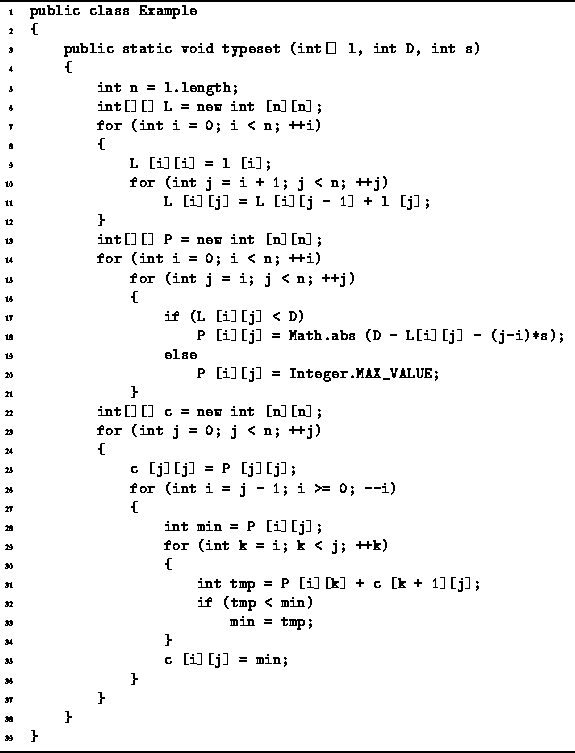Program ![]() defines the method typeset
which takes three arguments.
The first, l, is an array of n integers that
gives the lengths of the words in the sequence to be typeset.
The second, D, specifies the desired paragraph width
and the third, s, specifies the normal inter-word space.
defines the method typeset
which takes three arguments.
The first, l, is an array of n integers that
gives the lengths of the words in the sequence to be typeset.
The second, D, specifies the desired paragraph width
and the third, s, specifies the normal inter-word space.

Program: Dynamic programming example--typesetting a paragraph.
The method first computes the lengths, ![]() ,
of all possible subsequences (lines 6-12).
This is done by using the dynamic programming paradigm
to evaluate the recursive definition of
,
of all possible subsequences (lines 6-12).
This is done by using the dynamic programming paradigm
to evaluate the recursive definition of ![]() given in Equation
given in Equation ![]() .
The running time for this computation is clearly
.
The running time for this computation is clearly ![]() .
.
The next step computes the one-line penalties ![]() as given by Equation
as given by Equation ![]() (lines 13-21).
This calculation is a straightforward one
and its running time is also
(lines 13-21).
This calculation is a straightforward one
and its running time is also ![]() .
.
Finally, the minimum total costs, ![]() ,
of typesetting each subsequence are determined
for all possible subsequences (lines 22-37).
Again we make use of the dynamic programming paradigm
to evaluate the recursive definition of
,
of typesetting each subsequence are determined
for all possible subsequences (lines 22-37).
Again we make use of the dynamic programming paradigm
to evaluate the recursive definition of ![]() given in Equation
given in Equation ![]() .
The running time for this computation is
.
The running time for this computation is ![]() .
As a result, the overall running time required to
determine the best way to typeset a paragraph of n words is
.
As a result, the overall running time required to
determine the best way to typeset a paragraph of n words is ![]() .
.